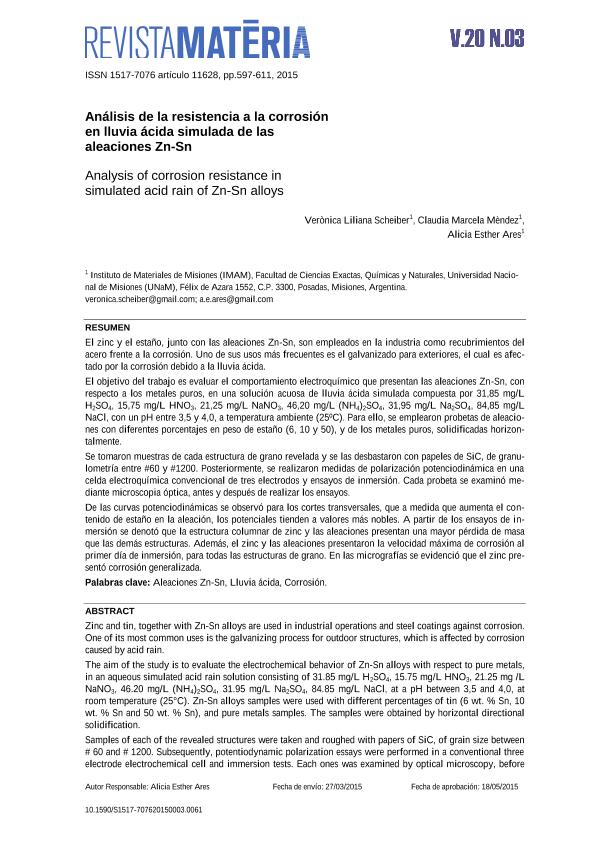Mostrar el registro sencillo del ítem
dc.contributor.author
Scheiber, Verónica Liliana
dc.contributor.author
Mendez, Claudia Marcela
dc.contributor.author
Ares, Alicia Esther

dc.date.available
2016-12-19T14:57:28Z
dc.date.issued
2015-09
dc.identifier.citation
Scheiber, Verónica Liliana; Mendez, Claudia Marcela; Ares, Alicia Esther; Análisis de la resistencia a la corrosión en lluvia ácida simulada de las aleaciones Zn-Sn; Univ Fed Rio de Janeiro; Revista Matéria; 20; 3; 9-2015; 597-611
dc.identifier.issn
1517-7076
dc.identifier.uri
http://hdl.handle.net/11336/9703
dc.description.abstract
Zinc and tin, together with Zn-Sn alloys are used in industrial operations and steel coatings against corrosion. One of its most common uses is the galvanizing process for outdoor structures, which is affected by corrosion caused by acid rain. The aim of the study is to evaluate the electrochemical behavior of Zn-Sn alloys with respect to pure metals, in an aqueous simulated acid rain solution consisting of 31.85 mg/L H2SO4, 15.75 mg/L HNO3, 21.25 mg /L NaNO3, 46.20 mg/L (NH4)2SO4, 31.95 mg/L Na2SO4, 84.85 mg/L NaCl, at a pH between 3,5 and 4,0, at room temperature (25°C). Zn-Sn alloys samples were used with different percentages of tin (6 wt. % Sn, 10 wt. % Sn and 50 wt. % Sn), and pure metals samples. The samples were obtained by horizontal directional solidification. Samples of each of the revealed structures were taken and roughed with papers of SiC, of grain size between # 60 and # 1200. Subsequently, potentiodynamic polarization essays were performed in a conventional three electrode electrochemical cell and immersion tests. Each ones was examined by optical microscopy, before and after performing the tests. For cross sections of samples, in potentiodynamic curves was observed that increasing tin content in the alloy, the potential tend to nobler values. From immersion tests was observed that the columnar structure of zinc and alloys exhibit greater mass loss than other structures. Moreover, zinc and alloys have high corrosion rates on the first day of immersion, for all grain structures. The micrographs showed that zinc presents generalized corrosion.
dc.description.abstract
Zinc and tin, together with Zn-Sn alloys are used in industrial operations and steel coatings against corrosion. One of its most common uses is the galvanizing process for outdoor structures, which is affected by corrosion caused by acid rain. The aim of the study is to evaluate the electrochemical behavior of Zn-Sn alloys with respect to pure metals, in an aqueous simulated acid rain solution consisting of 31.85 mg/L H2SO4, 15.75 mg/L HNO3, 21.25 mg /L NaNO3, 46.20 mg/L (NH4)2SO4, 31.95 mg/L Na2SO4, 84.85 mg/L NaCl, at a pH between 3,5 and 4,0, at room temperature (25°C). Zn-Sn alloys samples were used with different percentages of tin (6 wt. % Sn, 10 wt. % Sn and 50 wt. % Sn), and pure metals samples. The samples were obtained by horizontal directional solidification. Samples of each of the revealed structures were taken and roughed with papers of SiC, of grain size between # 60 and # 1200. Subsequently, potentiodynamic polarization essays were performed in a conventional three electrode electrochemical cell and immersion tests. Each ones was examined by optical microscopy, before and after performing the tests. For cross sections of samples, in potentiodynamic curves was observed that increasing tin content in the alloy, the potential tend to nobler values. From immersion tests was observed that the columnar structure of zinc and alloys exhibit greater mass loss than other structures. Moreover, zinc and alloys have high corrosion rates on the first day of immersion, for all grain structures. The micrographs showed that zinc presents generalized corrosion
dc.format
application/pdf
dc.language.iso
spa
dc.publisher
Univ Fed Rio de Janeiro

dc.rights
info:eu-repo/semantics/openAccess
dc.rights.uri
https://creativecommons.org/licenses/by-nc-sa/2.5/ar/
dc.subject
Aleaciones Zn-Sn
dc.subject
Lluvia Ácida
dc.subject
Corrosión
dc.subject.classification
Otras Ingeniería de los Materiales

dc.subject.classification
Ingeniería de los Materiales

dc.subject.classification
INGENIERÍAS Y TECNOLOGÍAS

dc.title
Análisis de la resistencia a la corrosión en lluvia ácida simulada de las aleaciones Zn-Sn
dc.title
Analysis of corrosion resistance in simulated acid rain of Zn-Sn alloys
dc.type
info:eu-repo/semantics/article
dc.type
info:ar-repo/semantics/artículo
dc.type
info:eu-repo/semantics/publishedVersion
dc.date.updated
2016-12-16T17:55:17Z
dc.journal.volume
20
dc.journal.number
3
dc.journal.pagination
597-611
dc.journal.pais
Brasil

dc.journal.ciudad
Rio de Janeiro
dc.description.fil
Fil: Scheiber, Verónica Liliana. Provincia de Misiones. Comite de Desarrollo E Innovacion Tecnologica; Argentina. Consejo Nacional de Investigaciones Cientificas y Tecnicas. Centro Cientifico Tecnológico Nordeste. Instituto de Materiales de Misiones; Argentina
dc.description.fil
Fil: Mendez, Claudia Marcela. Universidad Nacional de Misiones; Argentina. Consejo Nacional de Investigaciones Cientificas y Tecnicas. Centro Cientifico Tecnológico Nordeste. Instituto de Materiales de Misiones; Argentina
dc.description.fil
Fil: Ares, Alicia Esther. Consejo Nacional de Investigaciones Cientificas y Tecnicas. Centro Cientifico Tecnológico Nordeste. Instituto de Materiales de Misiones; Argentina
dc.journal.title
Revista Matéria

dc.relation.alternativeid
info:eu-repo/semantics/altIdentifier/url/http://ref.scielo.org/d6mf8z
dc.relation.alternativeid
info:eu-repo/semantics/altIdentifier/doi/http://dx.doi.org/10.1590/S1517-707620150003.0061
Archivos asociados
